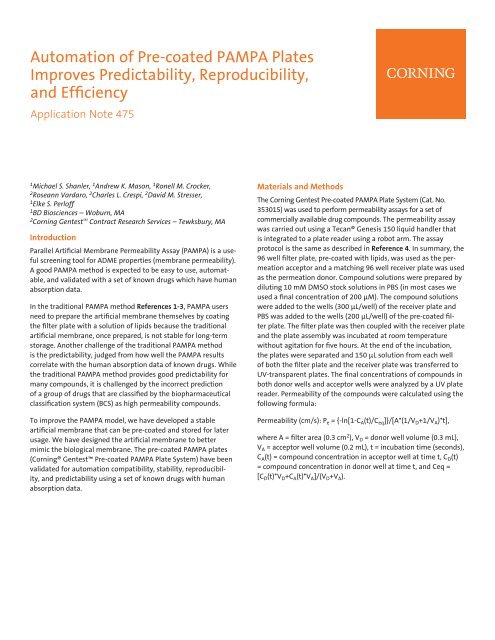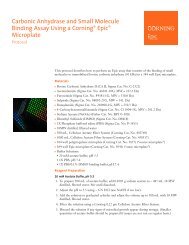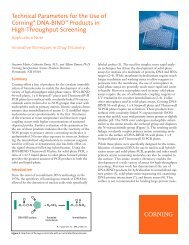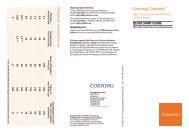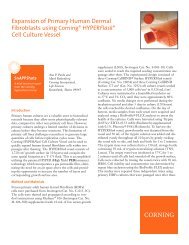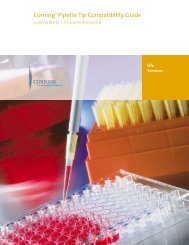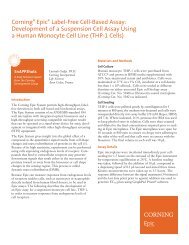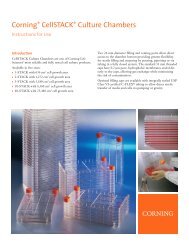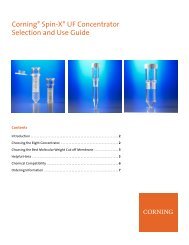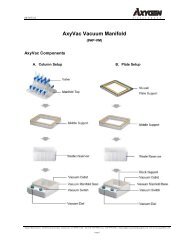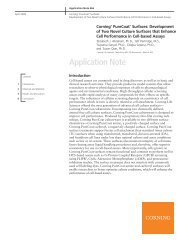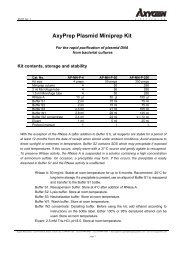Automation of Pre-coated PAMPA Plates Improves Predictability ...
Automation of Pre-coated PAMPA Plates Improves Predictability ...
Automation of Pre-coated PAMPA Plates Improves Predictability ...
You also want an ePaper? Increase the reach of your titles
YUMPU automatically turns print PDFs into web optimized ePapers that Google loves.
<strong>Automation</strong> <strong>of</strong> <strong>Pre</strong>-<strong>coated</strong> <strong>PAMPA</strong> <strong>Plates</strong><strong>Improves</strong> <strong>Pre</strong>dictability, Reproducibility,and EfficiencyApplication Note 4751 Michael S. Shanler, 1 Andrew K. Mason, 1 Ronell M. Crocker,2 Roseann Vardaro, 2 Charles L. Crespi, 2 David M. Stresser,1 Elke S. Perl<strong>of</strong>f1 BD Biosciences – Woburn, MA2 Corning Gentest SM Contract Research Services – Tewksbury, MAIntroductionParallel Artificial Membrane Permeability Assay (<strong>PAMPA</strong>) is a usefulscreening tool for ADME properties (membrane permeability).A good <strong>PAMPA</strong> method is expected to be easy to use, automatable,and validated with a set <strong>of</strong> known drugs which have humanabsorption data.In the traditional <strong>PAMPA</strong> method References 1-3, <strong>PAMPA</strong> usersneed to prepare the artificial membrane themselves by coatingthe filter plate with a solution <strong>of</strong> lipids because the traditionalartificial membrane, once prepared, is not stable for long-termstorage. Another challenge <strong>of</strong> the traditional <strong>PAMPA</strong> methodis the predictability, judged from how well the <strong>PAMPA</strong> resultscorrelate with the human absorption data <strong>of</strong> known drugs. Whilethe traditional <strong>PAMPA</strong> method provides good predictability formany compounds, it is challenged by the incorrect prediction<strong>of</strong> a group <strong>of</strong> drugs that are classified by the biopharmaceuticalclassification system (BCS) as high permeability compounds.To improve the <strong>PAMPA</strong> model, we have developed a stableartificial membrane that can be pre-<strong>coated</strong> and stored for laterusage. We have designed the artificial membrane to bettermimic the biological membrane. The pre-<strong>coated</strong> <strong>PAMPA</strong> plates(Corning® Gentest <strong>Pre</strong>-<strong>coated</strong> <strong>PAMPA</strong> Plate System) have beenvalidated for automation compatibility, stability, reproducibility,and predictability using a set <strong>of</strong> known drugs with humanabsorption data.Materials and MethodsThe Corning Gentest <strong>Pre</strong>-<strong>coated</strong> <strong>PAMPA</strong> Plate System (Cat. No.353015) was used to perform permeability assays for a set <strong>of</strong>commercially available drug compounds. The permeability assaywas carried out using a Tecan® Genesis 150 liquid handler thatis integrated to a plate reader using a robot arm. The assayprotocol is the same as described in Reference 4. In summary, the96 well filter plate, pre-<strong>coated</strong> with lipids, was used as the permeationacceptor and a matching 96 well receiver plate was usedas the permeation donor. Compound solutions were prepared bydiluting 10 mM DMSO stock solutions in PBS (in most cases weused a final concentration <strong>of</strong> 200 µM). The compound solutionswere added to the wells (300 µL/well) <strong>of</strong> the receiver plate andPBS was added to the wells (200 µL/well) <strong>of</strong> the pre-<strong>coated</strong> filterplate. The filter plate was then coupled with the receiver plateand the plate assembly was incubated at room temperaturewithout agitation for five hours. At the end <strong>of</strong> the incubation,the plates were separated and 150 µL solution from each well<strong>of</strong> both the filter plate and the receiver plate was transferred toUV-transparent plates. The final concentrations <strong>of</strong> compounds inboth donor wells and acceptor wells were analyzed by a UV platereader. Permeability <strong>of</strong> the compounds were calculated using thefollowing formula:Permeability (cm/s): P e = {-ln[1-C A (t)/C eq ]}/[A*(1/V D +1/V A )*t],where A = filter area (0.3 cm 2 ), V D = donor well volume (0.3 mL),V A = acceptor well volume (0.2 mL), t = incubation time (seconds),C A (t) = compound concentration in acceptor well at time t, C D (t)= compound concentration in donor well at time t, and Ceq =[C D (t)*V D +C A (t)*V A ]/(V D +V A ).
(A) Traditional <strong>PAMPA</strong> Process Flowchart96 well Filter Plate, un<strong>coated</strong> 96 well Filter Plate, <strong>coated</strong> with lipidsCoat filterAdd donorplate with& acceptorlipidssolutions96 well Receiver PlateAcceptor solutionDonor solutionCoupleplatestogether forpermeationIncubateplates forseveralhoursAnalyze concentrations <strong>of</strong> donorand acceptor solutions using UVplate reader or using LC-MS.Calculate permeability from thedonor and acceptor concentrations.(B) New <strong>PAMPA</strong> Process Flowchart using Corning® Gentest <strong>Pre</strong>-<strong>coated</strong> <strong>PAMPA</strong> Plate System96 well Filter Plate, pre-<strong>coated</strong> with lipidsAcceptor solutionAdd donor& acceptorsolutions96 well Receiver PlateDonor solutionCoupleplatestogether forpermeationIncubateplates forseveralhoursAnalyze concentrations <strong>of</strong> donorand acceptor solutions using UVplate reader or using LC-MS.Calculate permeability from thedonor and acceptor concentrations.Figure 1. Experimental Setup <strong>of</strong> <strong>PAMPA</strong>• In the traditional <strong>PAMPA</strong> method, the user needs to prepare the artificial membrane by coatingthe filter plate with a lipids solution• In the new <strong>PAMPA</strong> method, the Corning Gentest <strong>Pre</strong>-<strong>coated</strong> <strong>PAMPA</strong> Plate System is ready to use,allowing the user to skip the step <strong>of</strong> preparing the artificial membraneTraditional <strong>PAMPA</strong> membrane constructionPorous filterArtificialmembraneCorning Gentest <strong>PAMPA</strong> membrane constructionPorous filterArtificialmembraneFigure 2. Comparison <strong>of</strong> the Traditional <strong>PAMPA</strong> Membrane and the Corning Gentest <strong>PAMPA</strong>MembraneTraditional <strong>PAMPA</strong> membrane construction:• Coated by user (by adding a solution <strong>of</strong> lipids in each well)• The porous filter is soaked with a solution <strong>of</strong> lipids• Excessive solvents• Long permeation pathwayCorning Gentest <strong>PAMPA</strong> membrane construction:• <strong>Pre</strong>-<strong>coated</strong> by manufacturer• A lipid-oil-lipid tri-layer structure is constructed in the pores <strong>of</strong> the porous filter• No excessive solvents• Short permeation pathway (closer to the biological membrane)Figure 3. Automated <strong>PAMPA</strong> Deck Layout on a Tecan® Genesis 150 Configured with an IntegratedRobotic Arm, UV Plate Reader, and IncubatorA standard Tecan Genesis 150 robot deck had the capacity to fit all the necessary consumables torun the assay: one (1) Corning Gentest <strong>Pre</strong>-<strong>coated</strong> <strong>PAMPA</strong> Plate System (Cat. No. 353015); three(3) Falcon® 96 Well UV Transparent Microplates (Cat. No. 353261), one (1) Falcon 96 well 2 mLPolypropylene Storage Plate (Cat. No. 353966); three (3) 200 µL and two (2) 1000 µL disposablepipet tip racks; and one (1) “dummy” receiver plate was used to rest the <strong>PAMPA</strong> insert during accessto the donor wells. Integrated to the robot are a UV Plate reader, temperature controlled incubator,and multiple hotel shelves.2
Figure 4. The Integrated Robot Gripper and Pipette Tips are Fully Compatible with the Corning®Gentest <strong>Pre</strong>-<strong>coated</strong> <strong>PAMPA</strong> Plate SystemThe Tecan® RoMa (robotic arm) was programmed with vectors to retrieve and manipulate individualcomponents <strong>of</strong> the assembly (lids, receiver, and donor components). The RoMa also transferredthe UV assay plates to the plate reader. Both 200 µL and 1000 µL conductive Tecan DiTi (disposabletips) were programmed to reproducibly aspirate and dispense with liquid level sensing and a1.0 mm <strong>of</strong>fset to minimize the risk <strong>of</strong> a membrane puncture or tear.Permeability Pe (10 -6 cm/s)12108642Plate 1 (1-month old)Plate 2 (6-month old)Plate 3 (12-month old)Permeability Pe (10 -6 cm/s)12108642Manual AssayAutomated Assay0famotidineamiloridefurosemidehydrochlorothiazideantipyrinecaffeinemetoprololnaproxen0famotidineamiloridefurosemidehydrochlorothiazideantipyrinecaffeinemetoprololnaproxenFigure 5. Reproducibility and Stability <strong>of</strong>the Corning Gentest <strong>Pre</strong>-Coated <strong>PAMPA</strong>Plate SystemComparison <strong>of</strong> <strong>PAMPA</strong> permeability values<strong>of</strong> 8 compounds obtained using 3 pre-<strong>coated</strong>plates prepared at different times: Plate 1 wasprepared one month before the day <strong>of</strong> assay,Plate 2 was prepared 6 months before the day<strong>of</strong> assay, Plate 3 was prepared one year beforethe day <strong>of</strong> assay.Figure 6. Automated Assay Improved CVCompared to Manual AssayComparison <strong>of</strong> <strong>PAMPA</strong> permeability values <strong>of</strong> 8compounds obtained using manual assay andautomated assay methods. The automatedassay method produced better CVs.A. Traditional <strong>PAMPA</strong> Membrane B. Corning Gentest <strong>PAMPA</strong> MembraneHuman Absorption (%FA)False negativeLow PermeabilityHigh PermeabilityFalse positiveHuman Absorption (%FA)False negativeLow PermeabilityHigh PermeabilityFalse positiveLog P e (cm/s)Log P e (cm/s)Figure 7. Corning Gentest <strong>PAMPA</strong> Membrane <strong>Improves</strong> Correlation with Human Absorption DataComparison <strong>of</strong> the performance <strong>of</strong> traditional <strong>PAMPA</strong> membrane and the Corning Gentest <strong>PAMPA</strong>membrane by analyzing the correlation <strong>of</strong> the permeability data with the human absorption datafor a set <strong>of</strong> 35 compounds. The permeability data <strong>of</strong> the traditional <strong>PAMPA</strong> membrane and thehuman absorption data were cited from Reference 3. The permeability data <strong>of</strong> the Corning Gentest<strong>Pre</strong>-Coated <strong>PAMPA</strong> Plate System membrane were obtained using UV VIS measurements; bothdonor and acceptor buffers were PBS, pH 7.4; and the <strong>PAMPA</strong> plate system was incubated at roomtemperature for 5 hours without agitation.3
ResultsThe Corning® Gentest <strong>Pre</strong>-<strong>coated</strong> <strong>PAMPA</strong> Plate System simplifiesthe <strong>PAMPA</strong> process since effort is not required to form andprepare the membrane prior to adding the compounds. Figure 1compares the traditional <strong>PAMPA</strong> process flowchart and the new<strong>PAMPA</strong> process flowchart. The traditional process requires theuser to perform coating <strong>of</strong> the filter plate before setting up theassay. In the new process, the filter plate is ready to use, thereforethe assay can be started by the addition <strong>of</strong> compounds tothe Donor wells, addition <strong>of</strong> buffer to the Acceptor wells, andcoupling the Donor and Acceptor plates together for incubation.Overall time required to run the assay is greatly reduced whencompared to traditional methods.The new artificial membrane is designed not only to improvethe stability, but also to improve the <strong>PAMPA</strong> model. Traditional<strong>PAMPA</strong> membrane has incorrect predictions for some high permeabilitycompounds, presumably due to the excessive amount <strong>of</strong> solventspresent in the membrane structure. Figure 2 compares thestructure <strong>of</strong> the artificial membrane <strong>of</strong> the traditional <strong>PAMPA</strong> andthe Corning Gentest <strong>Pre</strong>-<strong>coated</strong> <strong>PAMPA</strong> Plate System. The traditional<strong>PAMPA</strong> membrane is prepared by adding a solution <strong>of</strong> lipids.As a result, the porous filter is soaked with the solvent <strong>of</strong> thelipids, creating a long permeation pathway for the compounds.In comparison, the Corning Gentest <strong>Pre</strong>-<strong>coated</strong> <strong>PAMPA</strong> PlateSystem <strong>PAMPA</strong> membrane is prepared by constructing thin layers<strong>of</strong> lipids inside the porous filter, using volatile solvents whichevaporate after coating. Therefore, the permeation pathway ismuch shorter and is a better mimic <strong>of</strong> the biological membrane.The Corning Gentest <strong>Pre</strong>-<strong>coated</strong> <strong>PAMPA</strong> Plate System is fullyautomation compatible. This is demonstrated by carrying outthe entire assay process using a Tecan® Genesis 150 liquidhandler which is integrated to a plate reader using a robot arm.The automation deck layout is shown in Figure 3 and examples<strong>of</strong> robotic handling are shown in Figure 4.To validate the stability <strong>of</strong> the pre-<strong>coated</strong> plates, experimentshave been carried out using plates <strong>coated</strong> at different times.Figure 5 compares the results obtained from three plates <strong>coated</strong>at different times and used for assay on the same day. The resultsobtained from the one-year-old plate and the six-month-old plateare almost identical to the results obtained from a freshly <strong>coated</strong>plate. These results indicate that the Corning Gentest <strong>Pre</strong>-<strong>coated</strong><strong>PAMPA</strong> Plate System is stable for at least one year when stored at-20°C and is highly reproducible from plate to plate.For Research Use Only. Not for use in diagnostic or therapeutic procedures.For a listing <strong>of</strong> trademarks, visit us at www.corning.com/lifesciences/trademarks.Other trademarks are the property <strong>of</strong> their respective owners.Corning Incorporated, One Riverfront Plaza, Corning, NY 14831-0001To validate the automation <strong>of</strong> the pre-<strong>coated</strong> plates, theresults obtained using automated assays were compared tothe results obtained using manual assays. The results shown inFigure 6 confirmed that both methods yielded the same results,while the automated methods generated data with tighterCVs, presumably due to more accurate pipetting compared tomanual pipetting.Figure 7 compares the performance <strong>of</strong> a traditional <strong>PAMPA</strong> andthe Corning Gentest <strong>Pre</strong>-Coated <strong>PAMPA</strong> Plate System by analyzingthe correlation <strong>of</strong> the permeability data with the humanabsorption data <strong>of</strong> 35 compounds. Using the traditional <strong>PAMPA</strong>,there is a group <strong>of</strong> compounds with high human absorption propertiesthat are under-predicted (false negative). This group <strong>of</strong>compounds are correctly predicted using the Corning Gentest<strong>Pre</strong>-Coated <strong>PAMPA</strong> Plate System.ConclusionsThe Corning Gentest <strong>Pre</strong>-Coated <strong>PAMPA</strong> Plate System is fully automationcompatible and improves the <strong>PAMPA</strong> model through thefollowing characteristics:w <strong>Pre</strong>-<strong>coated</strong> plates improve process efficiency because themembrane preparation step is skippedw <strong>Pre</strong>-<strong>coated</strong> plates are stable and highly reproducible fromplate to platew The new artificial membrane better mimics the biological membraneand improves <strong>PAMPA</strong> predictability, as demonstrated bythe improved correlation with human absorption dataReferences1. Kansy, M., Senner, F., Gubernator, K. J. Med. Chem. 41:1007(1998).2. Avdeef, A., Strafford, M., Block, E., Balogh, M., Chambliss, W.,Khan, I. Eur. J. Pharm. Sci. 14:271 (2001).3. Ruell, J.A., Avdeef, A., Du, C., Tsinman, K. A Simple <strong>PAMPA</strong>Filter for Passively Absorbed Compounds, Poster, ACS NationalMeeting, Boston, August 2002.4. Chen, X., Murawski, A, Patel, K., Crespi, C. L., Balimane, P.,Pharmaceutical Research, in press (2008).Corning acquired the Falcon® and Gentest brands.For additional Corning product, technical, or distributor information,please e-mail us at CLSTechServ@corning.com, visit ourwebsite www.corning.com/lifesciences or call 800.492.1110.Outside the United States, call 978.442.2200. For informationon the acquisition, visit www.corning.com/discoverylabware.Corning IncorporatedLife Sciences836 North St.Building 300, Suite 3401Tewksbury, MA 01876t 800.492.1110t 978.442.2200f 978.442.2476www.corning.com/lifesciences© 2012, 2013 Corning Incorporated Printed in U.S.A. 5/13 CLS-DL-GT-053


